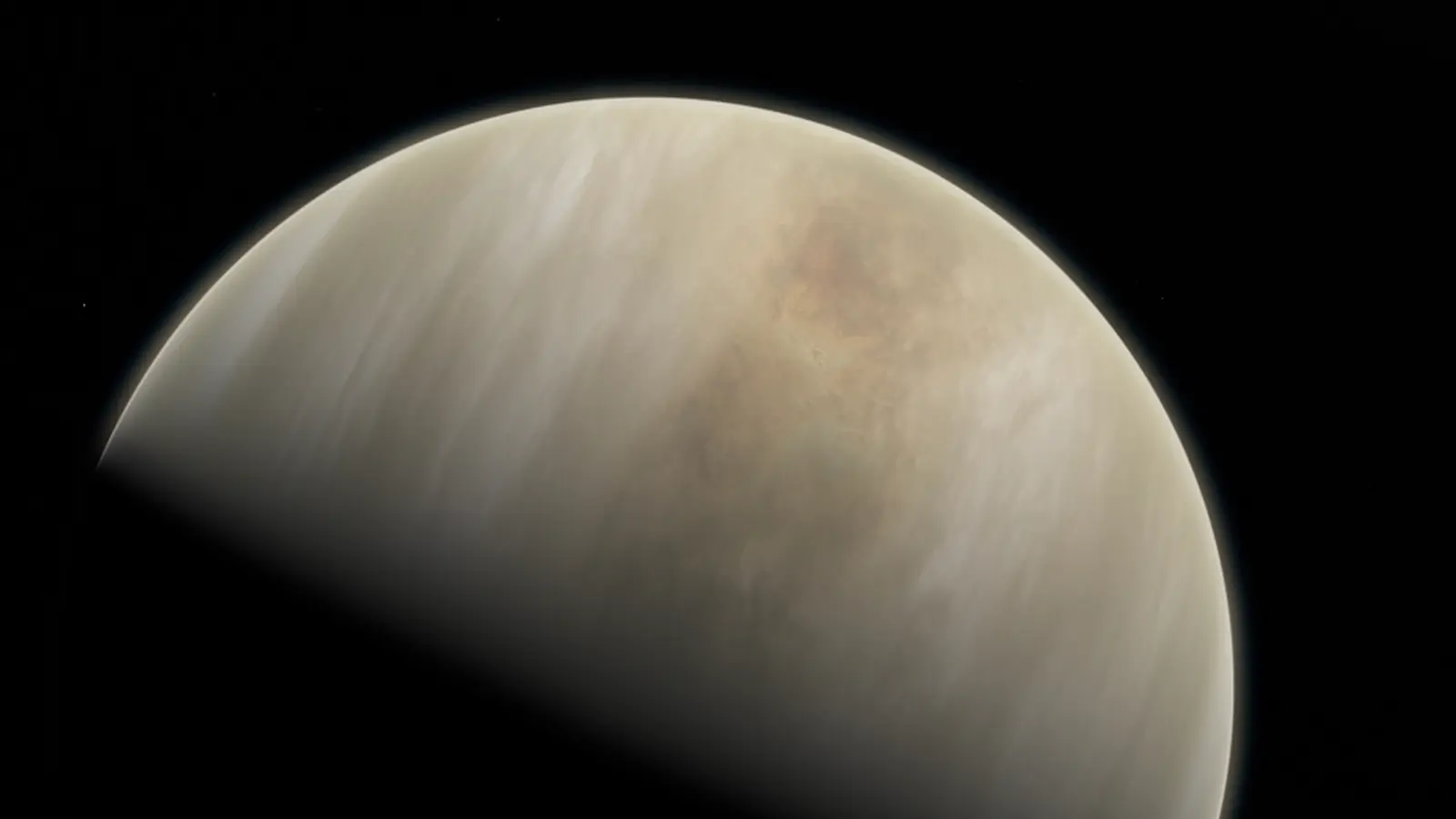7 Minutes
New Read on Old Data: Water in Venus' Clouds
Revisiting archived spacecraft measurements with modern tools and perspective has become a powerful approach in planetary science. A recent reanalysis of 1970s Pioneer Venus probe data by a team of U.S. researchers has produced one of the most surprising results in decades: Venus' cloud aerosols contain far more water, bound in hydrated compounds, than previously recognized. This finding updates our picture of the Venusian cloud deck and has immediate implications for atmospheric chemistry and the ongoing debate about habitability in Venus' temperate cloud layer.
Scientific context: Why Venus' clouds matter
Venus is often described as Earth’s twin gone wrong: similar in size and bulk composition, but subjected to a runaway greenhouse that created a dense CO2 atmosphere and surface temperatures hot enough to melt lead. Yet some parts of Venus' atmosphere—between roughly 48 and 60 kilometers altitude—have pressures and temperatures that overlap with Earth-like conditions. That temperate layer has attracted astrobiologists and atmospheric chemists because the clouds there could, in principle, host chemical niches for microbial life or at least complex chemistry.
Historically, the dominant paradigm held that Venus' clouds were composed primarily of concentrated sulfuric acid droplets. Remote sensing of vapor-phase water and sulfur species supported an atmosphere with only trace aqueous content. However, in-situ measurements taken by descent probes, which directly sample aerosols, can reveal bound or particulate water that remote spectroscopy might miss. The new paper reexamines the Pioneer Venus Large Probe mass-spectrometry and gas-chromatograph records with precisely this distinction in mind.

Mission data and reanalysis methods
The data set originates from two instruments on the Pioneer Venus Large Probe: the Large Probe Neutral Mass Spectrometer (LNMS) and the Large Probe Gas Chromatograph (LGC). As the probe descended through the cloud layers, the instrument inlets encountered dense aerosol loadings. The original teams in the 1970s recorded abrupt, temporary changes in measured gas concentrations—most notably a dramatic, transient drop in CO2 readings—at cloud-entry altitudes. Those anomalies were logged but not fully interpreted.
Researchers led by Rakesh Mogul and Sanjay Limaye tracked down the original telemetry stored on microfilm in NASA's Space Science Data Coordinated Archive. After digitizing the microfilm and reprocessing the raw spectra with modern calibration knowledge and thermal-decomposition modeling, they treated the probe inlet clogging as an opportunity rather than a failure. The instruments effectively collected aerosol material that later vaporized or decomposed as the probe warmed or as the probe frictionally heated the inlet, producing characteristic gas release signatures at specific temperatures. By correlating gas-release peaks with decomposition temperatures, the team identified the chemical nature of the aerosol phases.
Thermal release and mass-spectrometry fingerprints
Key thermal release features were: large water releases at approximately 185°C and 414°C; strong SO2 releases around 215°C and again near 397°C; and a coincident iron-ion signal at the higher-temperature SO2 release. The lower-temperature water release points to hydrated salts and minerals (for example, hydrated magnesium sulfate), while the higher-temperature water and iron/SO2 signatures match thermal decomposition of ferric sulfate into iron oxides and sulfur oxides.
Using quantitative processing of LNMS and LGC signals, the reanalysis estimates that roughly 62% of aerosol mass was water bound in hydrates rather than free liquid droplets. Sulfuric acid remains present—about 22% of the identified aerosol mass in the study—but ferric sulfate and related iron-bearing sulfates could represent roughly 16% of the aerosol mass. These proportions shift the view of Venusian cloud chemistry from near-exclusive sulfuric acid dominance to a mixed aerosol population with abundant hydrated phases.
Key discoveries and implications
The most consequential result is that Venus' clouds contain significant water, but much of it is chemically bound in hydrated salts and mineral phases. This explains a long-standing discrepancy between remote-sensing measurements, which largely detect vapor-phase water, and in-situ probe results, which sample the bulk aerosol mass. Remote spectroscopy underestimates total water content because bound water in hydrates does not show the same spectral features as free water vapor or liquid droplets.
For atmospheric chemistry, the presence of hydrated sulfates and iron-bearing sulfates implies active aerosol chemistry driven by influxes of cosmic dust, sulfur photochemistry, and heterogeneous reactions in the acidic cloud environment. The detection of iron suggests micrometeoroid material is processed within the cloud deck and reacts with sulfur-bearing species to generate ferric sulfate particles.
For astrobiology, the revised water budget reopens discussions about habitability of the mid-cloud layer. While the environment remains highly acidic and oxidizing, an increased inventory of water—even if chemically bound in hydrates—modifies estimates for transient liquid microenvironments, potential buffering phases, and the energetic and chemical resources available for hypothetical microbial chemistry. The authors caution that abundance of water alone does not prove habitability; pH, oxidant levels, and stability of microenvironments remain key constraints.
Expert Insight
"Recovering and reinterpreting Pioneer Venus data shows how valuable archival missions can be," said Dr. Elena Marquez, atmospheric chemist at the Institute for Planetary Studies. "The detection of hydrated aerosols suggests there are dynamic chemical processes in the cloud layer that we underestimated. For mission planners, this means future probes should include instruments designed to distinguish bound versus free water and to capture aerosol mineralogy directly."
Dr. Marquez's comment underscores the practical lesson of this study: well-preserved legacy data, when combined with targeted laboratory and modeling work, can yield discoveries on par with new missions.
Related technologies and future prospects
This reanalysis strengthens the scientific case for future Venus missions that carry advanced in-situ aerosol collectors, high-resolution mass spectrometers, and microanalytical laboratories capable of detecting hydrated minerals and trace metal content. Planned or proposed missions such as DAVINCI+, VERITAS, Venera-D, and various balloon platforms could directly test the new predictions by sampling cloud aerosols at multiple altitudes and local times.
Laboratory work replicating Venus cloud temperatures and acidities will also be essential to confirm the thermal-release pathways and to validate mineral identifications from mass-spectra fingerprints. Additionally, orbital remote-sensing campaigns using updated spectral libraries that include signatures of hydrated sulfates and iron-bearing phases could help reconcile remote and in-situ datasets across the globe.
Conclusion
The reexamination of Pioneer Venus Large Probe data demonstrates that Venus' cloud aerosols are more chemically complex than previously thought, with a substantial fraction of their mass accounted for by water bound in hydrated minerals and salts. While sulfuric acid remains an important constituent, the discovery of ferric sulfates and hydrated phases reframes atmospheric chemistry and influences assessments of cloud-layer habitability. This work highlights the scientific value of archival data and bolsters the case for targeted in-situ investigations on upcoming Venus missions.
Source: sciencealert


Leave a Comment